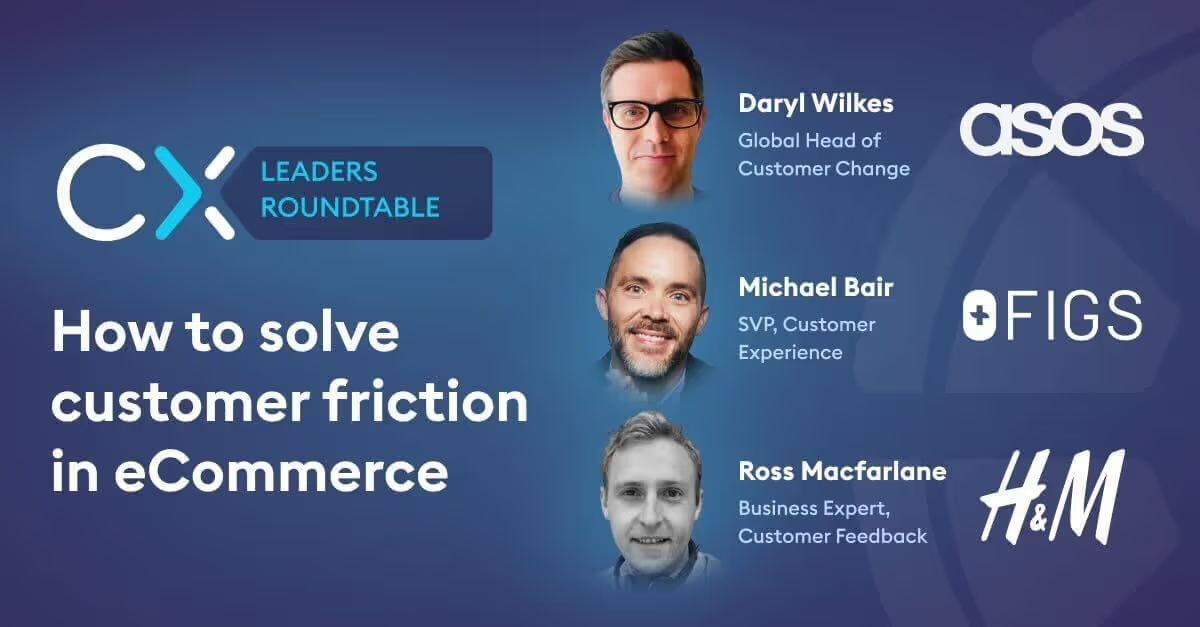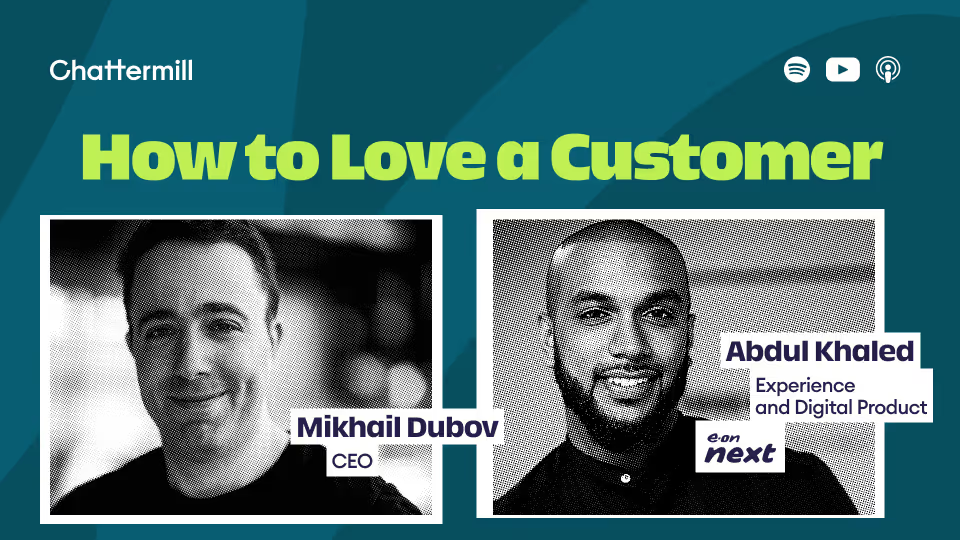Customer friction is one of the stickiest problems for CX leaders in eCommerce. Friction-full customer journeys provide a sub-optimal experience for customers while also being a significant driver of brands’ customer retention issues.
So what’s the best way to solve them? We sought to find out that in the latest CX Leaders Roundtable webinar.
We brought together some of the brightest minds from retail and eCommerce big hitters, including:
- Daryl Wilkes – Global Head of Customer Change at ASOS.
- Michael Bair – SVP of Customer Experience at US healthcare apparel brand, FIGS.
- Ross Macfarlane – Business Expert of Customer Feedback at H&M.
Why? So we could dig into understanding the actual cost of friction during the customer journey, as well as understand how eCommerce brands can move from a responsive position to a proactive one in terms of when these issues arise and how best they can be dealt with.
Read on for our key takeaways from the discussion. The full roundtable – including the Q&A – is available on-demand below. Make sure you give it a watch!
Right, let’s begin.

CX Leaders Roundtable: How to solve customer friction in eCommerce - Chattermill
How Critical is a Frictionless Customer Experience?
We know that here in the UK, friction in the shopping journey costs eCommerce businesses around £36bn yearly.

We also know that most consumers will switch to a competitor if they have a terrible experience. Around the same proportion admit that they have dropped out of a shopping journey and moved on to other options due to these pain points.
So what is friction? For ASOS, it is anything that stops the customer from getting to the outcome they’re trying to achieve as quickly as possible, according to Daryl Wilkes.
‘On the buying side, friction will decrease your conversion rate,’ Michael Bair of FIGS says. ‘Every click, every drop-down, every piece of information that the customer has to enter – on their phone, particularly – is going to increase the likelihood they don’t order.’
‘On the post-sale side,’ Bair continues. ‘You want customers to trust you. They need to know that you’re there for them. How can we make working with us, buying from us, and being in a relationship with us as easy as possible?’
Ross Macfarlane of H&M reflects on friction as something that was observed when the business was more of an offline operation, whereas now it highlights the real blurring between the Bricks & Mortar and eCommerce space.
‘There’s a challenge in considering either the physical or the digital store in a vacuum,’ he says. ‘They (the customers) are really looking for a seamless experience between sales channels.’
So how do eCommerce businesses identify those friction areas across that multichannel journey?
For Bair, a good starting point is pulling up your top five contact reasons, then going through the customer journey and counting the number of clicks and/or emails that the customer needs to be able to complete that task.
For Wilkes, contact reasons are really important too.
‘Customers get in contact because something has either gone wrong or something has not gone how they expected it to play out,’ he says. ‘It’s about understanding those contacts but understanding the sentiment behind those contacts, matching up the contact reasons with the feedback you get from your customers, so the richness of that feedback is really strong.’
‘What that can do is not only inform you how you can improve the experience at that contact,’ he continues, ‘but also what drove the contact in the first place and actually where you can go hunting for the root cause of the friction.’
Wilkes highlights the importance for modern clothing businesses to be agile when addressing pain points – both in the lead-up to a sale and in the customer journey's delivery and fulfilment. But this leads to the question: are businesses too often on the back foot with friction?
Macfarlane describes how H&M is becoming more proactive about being prepared for friction. This is part and parcel of the business moving towards long-term customer experience rather than being centred on transactions.
As for ASOS, Wilkes describes the push towards making the entire journey feel like an ASOS journey all the way through – even if it involves separate fulfilment partners, etc.
‘How do we make the language in line with the brands? How do we tie each of those touchpoints together, even though one might be coming from ASOS and the next might be from the carrier partner?’ he asks. ‘There’s definitely more work to do in that space.’
Friction with Size and Fit (And How to Solve It)
Size and fit are huge friction points in clothing eCommerce. In Europe alone, returns due to incorrect size cost retailers more than €8.4bn. 40% of online apparel orders are returned, and 70% of those returns are due to problems with sizing and fit.

This has been a critical issue for Macfarlane and H&M.
‘We’ve now grown to be a global brand present in 50+ markets,’ he says. ‘We had a European size model that did not work for our UK customers, it did not work for our US customers, and it did not work for our Asian customers.’
‘We went on a long journey on listening to customers and getting customer input and really trying to decentralise the way we standardise our sizing.’
Macfarlane highlights that in partnering with Chattermill, H&M were able to discover that there was a different perception between size and fit. In short, the issue was more on sizing – alongside frequently reported negative sentiment around material thickness (customers would assume material was thicker or less transparent than it was in reality).
This called for tweaks to product pages, with more images and better detail to give customers a more comprehensive idea of what they will receive.
Bair continues on the topic and why this kind of detail unearthed by Chattermill is so crucial.
‘If the product doesn’t fit well, the size isn’t an issue. And if your sizing isn’t right, it doesn’t matter what the fit is,’ he says. ‘It’s often hard to parse out the feedback customers give you because they’re certainly not using size and fit consistently.’
Bair also highlights how important it is to understand baseline size and fitting. I.e. how different is your size and fit model compared to the competitors your shoppers might be used to?
Again, understanding the voice of the customer is valuable here.
‘We’ve got to make the returns process seamless for our customer, but we have to reduce unnecessary returns – size and fit is a massive part of that, Wilkes says. ‘We distinctly ask the customer to review the size guide. The more you can build up that feedback, the more you can use that feedback to inform other customers purchasing.’
How Do You Find Intelligence Amongst the Chaos?
Here at Chattermill, we’ve found that only 10% of CX professionals say they have a unified view of their customers.
This chimes with what today’s guests are saying, too. But market leaders are certainly making great strides toward Unified Customer Intelligence.
‘I think of data as your revenue,’ Bair says. ‘All forms of data and customer feedback is important, but you have to wait for the feedback you’re getting from different channels.’
‘Certain channels, for example, Facebook, are more public, but they’re probably a low portion and can get lost very quickly,’ he adds. ‘CX interactions are your biggest source, but their feedback is very one-to-one.’
Brands need to be able to unify these sources to understand them.
‘We want to try and link the feedback that we gather to identifiable customers and be able to then view the feedback they give in the context of where are they in their lifetime journey with us,’ Macfarlane says. ‘Are they new customers? Are they frequent customers? Are they customers that are about to churn?’
H&M have often found the customers giving feedback might be the more regular ones, meaning that some might be falling away due to friction, but there won’t be any feedback to back up the hard data. Macfarlane also highlights the need to leverage the experience of the frontline staff to understand their point of view on the biggest friction points.
For ASOS, it is still an evolving story, according to Wilkes. He highlights that they are making incremental steps towards a more unified view but still have lots of data and are unsure what to do with it. He also points to using bespoke A/B tests on customer treatments (e.g. refunds or referrals to partners) to understand the impact of poor experiences on order values and frequency down the line.
Bair points to the need to make broader business changes when it comes to friction.
‘A big part of being a CX leader is being able to create or further stoke customer-centricity throughout your organisation,’ he says. ‘You need to ensure the leadership really care about customers as much as you do.’
Adding to this, Macfarlane points to using data to truly understand detractors vs. promoters among their customer base. At H&M, they found that those who give the brand a higher NPS score were shopping nine times a year on average while those giving a low NPS were shopping an average of once.
Being able to signpost this is crucial for understanding the real lifetime value of your customers to the business as a whole. And it’s just as important for getting buy-in on CX for the future.
Watch the Webinar Again

CX Leaders Roundtable: How to solve customer friction in eCommerce - Chattermill















